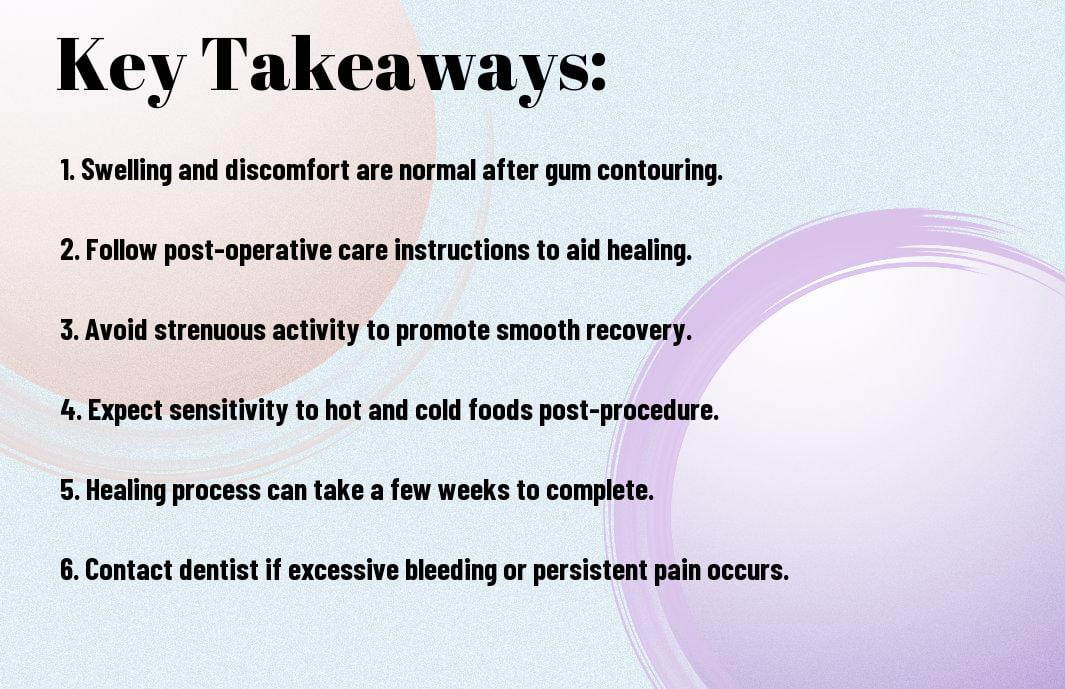With gum contouring, taking care of your oral health is crucial for a smooth recovery process. You may experience some discomfort initially, but knowing what to expect can help ease any concerns. In this informative guide, we’ll walk you through the recovery and healing process after gum contouring, providing you with the necessary information to ensure a successful outcome.
Key Takeaways:
- Patience is key: Recovery after gum contouring can take some time, so it’s necessary to be patient throughout the healing process.
- Minor discomfort is normal: You may experience some minor discomfort, swelling, or sensitivity after the procedure, but this is usually temporary and can be managed with proper care and medication.
- Follow post-operative instructions: It’s crucial to follow your dentist’s post-operative care instructions carefully to ensure proper healing and optimal results. This may include avoiding certain foods, practicing good oral hygiene, and attending follow-up appointments.
Preparing for Recovery
Following Post-Operative Instructions
Postoperative care is crucial for a successful recovery after gum contouring. Your dentist will provide you with specific instructions to follow after the procedure. It is necessary that you adhere to these guidelines to ensure proper healing and minimize the risk of complications. This may include information on how to care for the surgical site, what to eat, how to manage any discomfort, and when to follow up with your dentist for a post-operative check-up.
Managing Pain and Discomfort
Postoperative pain and discomfort are common after gum contouring. Your dentist may prescribe pain medication to help manage any discomfort you may experience. Additionally, applying ice packs to the affected area can help reduce swelling and alleviate pain. It is important to rest and avoid strenuous activities during the initial stages of recovery to allow your body to heal properly.
Another effective way to manage pain and discomfort after gum contouring is by practicing good oral hygiene. Gently brushing and flossing your teeth as instructed by your dentist can help prevent infection and promote healing. You may also be advised to rinse your mouth with a saltwater solution to keep the surgical site clean and aid in the healing process.
The Healing Process
What to Expect in the First 24 Hours
It is normal to experience some discomfort and swelling immediately after gum contouring. Your dentist may prescribe pain medication to help manage any pain. You can also apply an ice pack to the outside of your mouth for 20 minutes on, then 20 minutes off to reduce swelling. It is crucial to rest and avoid strenuous activities in the first 24 hours to aid in the healing process.
Swelling, Bruising, and Bleeding
Bruising may occur after gum contouring, but it should subside within a few days. Some slight bleeding is also normal; gently biting on a gauze pad can help control it. Swelling is typical and can peak around the second or third day before gradually decreasing. To minimize swelling, keep your head elevated while resting and avoid hot foods or drinks.
This healing process is a natural response to the trauma caused to the tissues during the gum contouring procedure. The body sends blood flow to the area to aid in healing, resulting in swelling and bruising. Although it may initially look alarming, these symptoms are temporary and should improve as you continue to recover.
Timeline for Recovery
On day three or four, you may begin to feel more comfortable as the swelling subsides. By the end of the first week, most of the swelling and bruising should be greatly reduced. It is necessary to follow your dentist’s post-operative instructions carefully, such as maintaining good oral hygiene and attending any follow-up appointments.
A full recovery from gum contouring typically takes about 6-8 weeks. During this time, your gums will continue to heal, and any residual swelling or tenderness will gradually diminish. Be patient with the healing process and remember that everyone’s recovery timeline may vary slightly.
Managing Swelling and Discomfort
Applying Ice Packs
Discomfort and swelling are common after gum contouring procedures. To help manage this, applying ice packs to the affected area can be very helpful. This can help reduce inflammation and numb the area, providing some relief from discomfort.
Elevating the Head
One effective way to reduce swelling and discomfort after gum contouring is to elevate your head while resting. By keeping your head elevated with an extra pillow or two, you can help promote proper drainage of fluids and reduce swelling in the treated area.
Elevating your head can also improve blood circulation, which aids in the healing process. This position can also help prevent any additional swelling and discomfort that may arise from lying flat.
Taking Pain Relievers
An vital part of managing discomfort after gum contouring is taking pain relievers as prescribed by your dentist or oral surgeon. Over-the-counter medications such as ibuprofen or acetaminophen can help alleviate any pain and discomfort you may experience during the recovery period.
The key is to follow your healthcare provider’s instructions carefully and not to exceed the recommended dosage to avoid any potential side effects.
Oral Hygiene During Recovery
All your efforts to maintain good oral hygiene are crucial during your recovery period after gum contouring. Following a few simple guidelines can help you heal properly and prevent complications.
Gentle Brushing and Flossing
Gentle brushing and flossing are imperative to keep your gums healthy during the recovery process. Use a soft-bristled toothbrush and be extra careful when brushing around the treated area. Avoid vigorous scrubbing, which can irritate the gums and delay healing. Floss gently to remove food particles and plaque, making sure not to put too much pressure on the gums.
Avoiding Irritants
To aid in your recovery, it’s important to steer clear of irritants that can cause discomfort or hinder healing. Avoid spicy, hot, or acidic foods and beverages that can aggravate the treated area. Smoking should also be avoided as it can slow down the healing process and increase the risk of complications. Stick to a soft diet and drink plenty of water to stay hydrated and promote healing.
Rinsing with Salt Water
Rinsing with salt water a few times a day can help keep the treated area clean and reduce inflammation. Mix a teaspoon of salt in a glass of warm water and swish it around your mouth for about 30 seconds before spitting it out. This gentle rinse can soothe the gums and promote healing without causing any discomfort.
This simple home remedy can be a soothing addition to your oral hygiene routine during your recovery period. The salt water helps to keep the area clean and reduce bacteria, aiding in the healing process.
Nutrition and Hydration
Many factors contribute to your recovery and healing after gum contouring, and proper nutrition and hydration play a crucial role in the process.
Eating Soft Foods
Foods that are soft and easy to chew are ideal during the initial stages of your recovery from gum contouring. Opt for foods like yogurt, smoothies, mashed potatoes, soups, and steamed vegetables. These choices will help you avoid putting excess pressure on your gums and promote a smooth healing process.
Staying Hydrated
Eating hydrating foods and drinking plenty of water is necessary for maintaining your overall health and facilitating the healing process after gum contouring. Proper hydration helps flush out toxins from your body and keeps your gums and mouth tissues moist, promoting better healing.
Staying well-hydrated also helps prevent complications such as dry mouth, which can lead to discomfort and slow down the healing of your gums. So, make sure to sip water throughout the day and include hydrating foods like fruits and vegetables in your diet.
Avoiding Spicy or Acidic Foods
With your gums in the healing phase after gum contouring, it’s crucial to avoid spicy or acidic foods that can irritate the surgical site and hinder the recovery process. Skip items like hot sauces, citrus fruits, tomatoes, and vinegar-based dishes to prevent discomfort and complications.
Plus, steering clear of spicy or acidic foods can also reduce the risk of inflammation and infection in your gums, allowing them to heal properly. Stick to mild, non-irritating foods to support your recovery and ensure a successful outcome from your gum contouring procedure.
Complications and When to Seek Help
Once again, gum contouring is a safe and common procedure, but like any dental treatment, there can be risks of complications. It’s important to be aware of these potential issues and know when to seek help from your dentist.
Infection and Other Complications
The most common complication after gum contouring is infection. This can occur if proper post-operative care is not followed, leading to pain, swelling, redness, and possible discharge from the surgical site. In rare cases, other complications such as excessive bleeding, allergic reactions to medications, or nerve damage may also arise.
Signs of Infection
On rare occasions, infections may develop after gum contouring. Signs of infection include increased pain, swelling that worsens instead of improving, persistent bleeding, foul odor or taste in your mouth, and fever. If you experience any of these symptoms, it’s important to contact your dentist immediately for evaluation and treatment.
Infection after gum contouring is rare but can be serious if left untreated. It’s crucial not to ignore any signs of infection and to seek prompt care from your dentist to prevent further complications.
Contacting Your Dentist
An important aspect of post-operative care after gum contouring is knowing when to reach out to your dentist. If you experience severe or worsening pain, excessive bleeding that does not subside, signs of infection, or any other concerning symptoms, do not hesitate to contact your dentist. They will be able to assess your condition and provide appropriate treatment to address any issues that may arise.
Signs of complications after gum contouring should not be ignored. Your dentist is there to support you throughout the recovery process, so don’t hesitate to reach out if you have any concerns or notice any abnormal symptoms.
Final Words
The recovery process after gum contouring may vary from person to person, but overall, you can expect some tenderness, swelling, and minor discomfort for a few days following the procedure. However, as your gums heal, you will start to see the beautiful results of your gum reshaping, and any discomfort will gradually subside. Remember to follow your dentist’s post-operative instructions carefully to ensure a smooth and successful recovery.
As you launch on your journey towards healing and recovery after gum contouring, trust in the expertise of your dental provider and give yourself the time and care needed to fully heal. With proper post-operative care and patience, you can expect to enjoy a more balanced and aesthetically pleasing smile that boosts your confidence and overall oral health. Recall, your well-being is worth investing in, so take the necessary steps to care for yourself throughout the recovery process.
FAQ
Q: What is gum contouring?
A: Gum contouring, also known as gum reshaping, is a cosmetic dental procedure that involves shaping the gums to create a more symmetrical and balanced smile. It can involve removing excess gum tissue or reshaping the gum line to improve the appearance of your teeth.
Q: What can I expect during the recovery period after gum contouring?
A: After gum contouring, you may experience some swelling, tenderness, and discomfort in the treated area. You may also have some minor bleeding and sensitivity to hot and cold temperatures. It is important to follow your dentist’s post-operative instructions, which may include taking pain medication, using a special mouthwash, and eating soft foods to aid in the healing process.
Q: How long does it take to fully heal after gum contouring?
A: The healing time after gum contouring can vary from person to person, but typically, most patients are fully healed within a few weeks. During this time, it is important to practice good oral hygiene, avoid hard or crunchy foods, and attend any follow-up appointments with your dentist to ensure proper healing and the best results from your gum contouring procedure.







